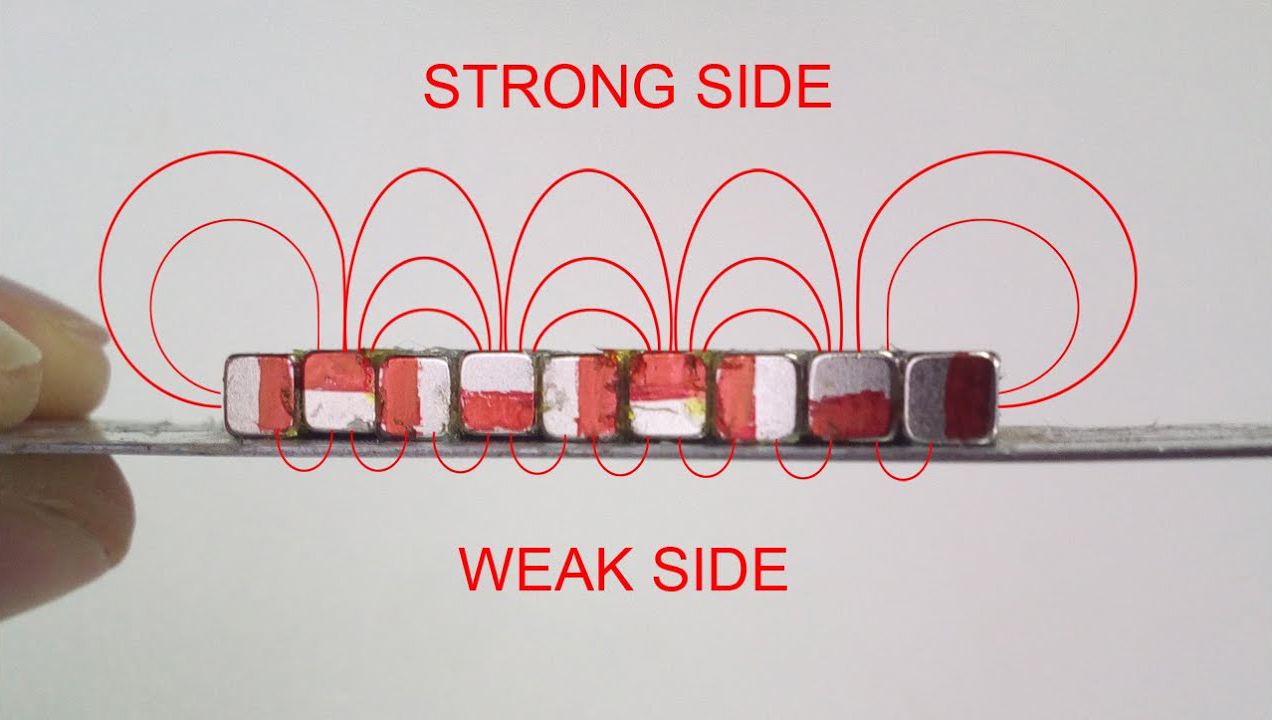Ever wonder how maglev trains float effortlessly above their tracks? Or why some refrigerator magnets stick so strongly on one side but barely attract anything on the other? The secret lies in something called a Halbach array.
And if you’re curious about magnetic engineering, particle physics, or just love learning about clever scientific innovations, you’re in for a treat.
In this guide, I’ll break down everything you need to know about what is a Halbach array, how they work, and why they’re revolutionizing everything from electric motors to MRI machines.
Sound good? Let’s dive in.

Table of Contents
What is a Halbach Array?
Here’s the deal: A Halbach array is a special arrangement of permanent magnets that creates a mind-blowing effect.
Instead of having magnetic fields spread out equally in all directions (like regular magnets), a Halbach array concentrates the magnetic field on one side while practically canceling it out on the other side.
Think of it like this:
Imagine you could take all the magnetic “power” that normally spreads in every direction and redirect it to focus on just one side. That’s exactly what a Halbach array does.
This “one-sided flux” effect was first discovered by John C. Mallinson in 1973, who initially described it as just a scientific curiosity. But in the 1980s, physicist Klaus Halbach independently reinvented this concept to focus particle beams in accelerators.
The result? A magnetic configuration that’s up to twice as strong on one side compared to traditional magnet arrangements.
How Does a Halbach Array Actually Work?
The magic happens through something called spatially rotating magnetization.
Instead of lining up all your magnets with their north poles pointing the same direction, you rotate each magnet’s orientation by a specific angle (usually 90 degrees for each subsequent magnet).
Here’s what happens:
- Side A (Working Side): All the magnetic field lines reinforce each other, creating an incredibly strong, concentrated field
- Side B (Non-Working Side): The magnetic fields cancel each other out, resulting in almost zero magnetic force
It’s like having multiple people push a car in the same direction versus having them push in different directions that cancel each other out.
Pro Tip: This isn’t just theoretical. You can actually see this effect with magnetic viewing film, which shows bright areas where magnetic fields are strong and dark areas where they’re weak or cancelled out.
Types of Halbach Array Configurations
Not all Halbach arrays are created equal. There are several different configurations, each designed for specific applications:
Linear (Planar) Halbach Arrays
These are flat, straight-line arrangements of magnets. They’re perfect for:
- Linear motors
- Magnetic levitation tracks
- Particle accelerator “wigglers”
Cylindrical Halbach Arrays
These wrap magnets around in a circular pattern, creating either:
- Inward-focused fields (strong field inside the cylinder)
- Outward-focused fields (strong field outside the cylinder)
Ring Halbach Arrays
Similar to cylindrical arrays but using ring-shaped magnets with multi-pole magnetization patterns.
Real-World Applications (You Probably Use These Every Day)
Here’s where things get really interesting. Halbach arrays aren’t just laboratory curiosities – they’re powering technology you interact with regularly.
Refrigerator Magnets
That flexible magnet holding your grocery list to the fridge? It’s probably using a Halbach array pattern.
These thin, printed magnets use alternating magnetic strips to create strong holding power on one side while having virtually no magnetic field on the printed side.
Electric Motors and Generators
Halbach arrays are revolutionizing motor design by:
- Increasing efficiency by up to 15-20%
- Reducing weight (no need for heavy iron cores)
- Enabling higher speeds (some can reach 10,000+ RPM)
- Improving power density
The secret? By eliminating the need for back iron or laminations, these motors dramatically reduce eddy current losses and hysteresis losses.
Magnetic Levitation (Maglev) Systems
Ever seen those incredible videos of maglev trains floating above tracks at 300+ mph?
Halbach arrays make this possible. The Inductrack maglev system uses these arrays to create the stable magnetic fields needed to lift trains weighing thousands of tons.
The physics is beautiful: As the Halbach array moves over metallic track coils, it induces voltages that create opposing magnetic fields, resulting in repulsion and levitation.
Medical Technology (MRI Machines)
Portable MRI scanners increasingly use Halbach cylinders to create strong, uniform magnetic fields without requiring:
- Cryogenic cooling
- External power sources
- Massive superconducting magnets
This makes MRI technology more accessible and cost-effective.
Scientific Equipment
Klaus Halbach originally developed these arrays for particle accelerators and free-electron lasers, where they’re known as “wiggler magnets”.
These applications require incredibly precise magnetic field control to guide electron beams and generate specific wavelengths of light.
Building a Halbach Array: What You Need to Know
Want to build your own? Here are the key considerations:
Magnet Selection
Neodymium magnets are typically the go-to choice because they offer:
- High magnetic strength
- Compact size
- Good temperature stability (with proper grades)
Assembly Challenges
Here’s the thing: All the magnets in a Halbach array repel each other.
This creates several engineering challenges:
- Extremely difficult assembly process
- Need for strong adhesives or mechanical fixtures
- Risk of magnets flying apart during construction
- Potential for neighboring magnet demagnetization
Pro Tip: Many manufacturers pre-magnetize the array after assembly to avoid these issues.
Magnetization Patterns
The most common patterns include:
- 90-degree rotation between adjacent segments
- Continuous rotation for smooth field transitions
- Variable spacing for specific field shaping requirements
Halbach Arrays vs. Traditional Magnet Assemblies
Let me break down the key differences:
Performance Comparison
| Configuration | Pull Force | Field Strength | Efficiency |
|---|---|---|---|
| Halbach Array | 72 lbs | Very High (One Side) | Excellent |
| All North Up | 77 lbs | High (Both Sides) | Good |
| Alternating N-S | 88 lbs | High (Both Sides) | Good |
| Mounting Magnet | 84 lbs | High (One Side) | Very Good |
Based on testing with five 1/2″ cube magnets
The bottom line? If you need maximum pull force to a steel surface, alternating pole arrangements actually work better than Halbach arrays.
But here’s where Halbach arrays shine: applications with air gaps.
When there’s space between the magnet and the target, Halbach arrays significantly outperform traditional configurations.
Advantages of Halbach Array Design
Increased Field Strength
- Up to 2x stronger magnetic field on the working side
- More efficient use of magnetic material
- Higher energy density
Field Confinement
- Near-zero stray field on the non-working side
- Reduced interference with surrounding components
- Better electromagnetic compatibility
Weight Efficiency
- No need for heavy iron backing
- Lighter overall system design
- Better power-to-weight ratios
Improved Efficiency
- Reduced core losses in motor applications
- Lower eddy current losses
- Higher overall system efficiency
Disadvantages and Limitations
Let’s be honest – Halbach arrays aren’t perfect:
Manufacturing Complexity
- Extremely difficult assembly due to repelling forces
- Requires specialized tooling and fixtures
- Higher manufacturing costs
- Need for skilled technicians
Demagnetization Risk
- Neighboring magnets can demagnetize each other
- Particularly problematic at elevated temperatures
- Requires high-coercivity magnet materials
- May limit operating temperature range
Cost Considerations
- Higher upfront manufacturing costs
- More expensive than traditional magnet assemblies
- Requires premium magnet materials
- Specialized design expertise needed
Future Applications and Emerging Trends
The applications for Halbach arrays continue to expand as technology advances:
Magnetic Refrigeration
This emerging cooling technology uses magnetic fields instead of traditional refrigerants, potentially revolutionizing HVAC systems while being more environmentally friendly.
Wireless Power Transfer
Halbach arrays could improve the efficiency of wireless charging systems for electric vehicles and consumer electronics.
Magnetic Bearings
Contactless bearing systems using Halbach arrays can eliminate friction and wear in high-speed rotating machinery.
Space Applications
The weight efficiency and reliability of Halbach arrays make them attractive for satellite systems and space exploration equipment.
Optimizing Halbach Array Performance
If you’re working on a Halbach array project, here are some key optimization strategies:
Segment Count
- More segments = smoother field distribution
- Diminishing returns after 8-12 segments for most applications
- Balance between performance and manufacturing complexity
Magnet Quality
- Use high-grade neodymium magnets (N42 or higher)
- Consider temperature stability requirements
- Ensure consistent magnetization across all segments
Assembly Techniques
- Use non-magnetic fixtures during assembly
- Consider magnetizing after assembly when possible
- Implement robust adhesive bonding strategies
The Bottom Line on Halbach Arrays
What is a Halbach array? It’s one of the most elegant solutions in magnetic engineering – a way to bend and concentrate magnetic fields exactly where you need them.
While they’re not the answer for every magnetic application, Halbach arrays excel in situations requiring:
- High field strength with air gaps
- Minimal stray magnetic fields
- Weight-efficient designs
- High-performance rotating machinery
As we move into 2025 and beyond, expect to see Halbach arrays playing increasingly important roles in electric vehicles, renewable energy systems, medical devices, and advanced manufacturing equipment.
The key is understanding when and how to use them effectively – and now you have the knowledge to make that determination.
Whether you’re an engineer working on the next breakthrough in magnetic levitation or just someone fascinated by clever physics, understanding what is a Halbach array opens up a world of possibilities in magnetic design and engineering.



